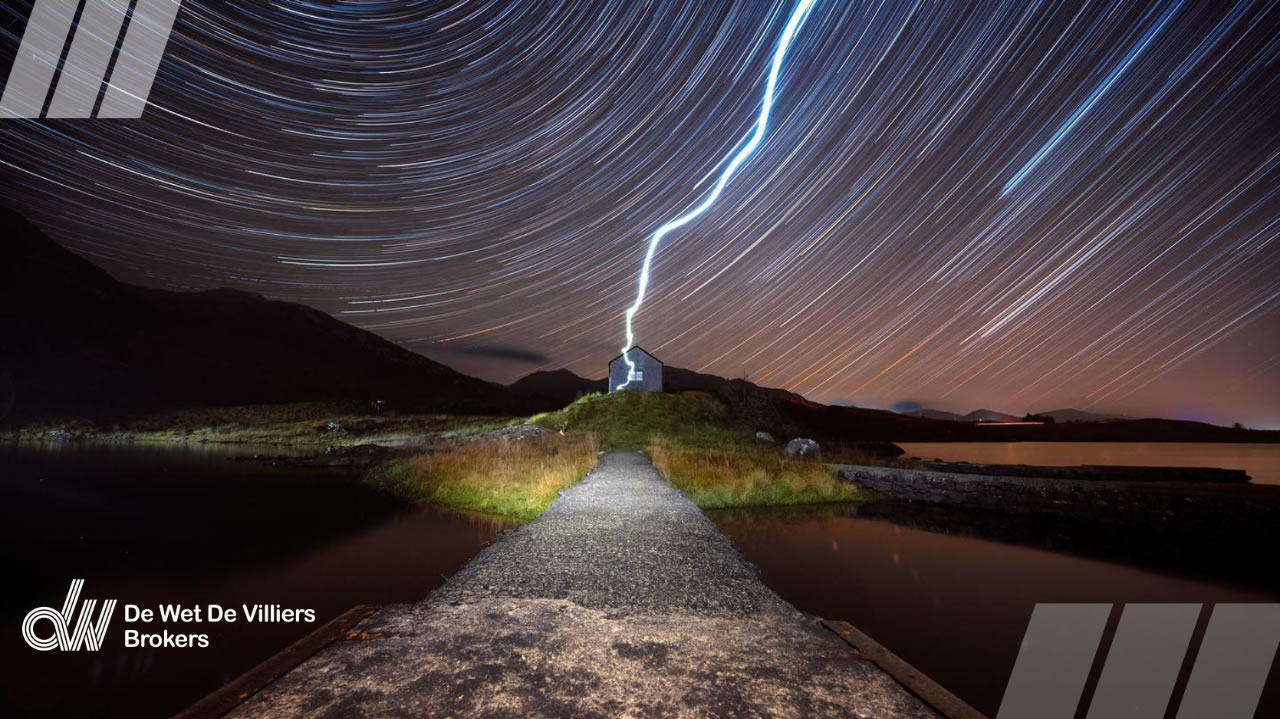According to Property24, South Africa has one of the highest lightning ground strike densities in the world, which can have major financial repercussions for businesses and local homeowners. It is therefore imperative to take steps to prevent the dangerous effects of lightning and to empower yourself by understanding how lightning can influence your insurance premium. To help you, we have compiled some important information.
What is lightning?
The National Weather Service explains that lightning is a giant spark of electricity in the atmosphere, or between the atmosphere and the ground. It can occur between opposite charges within the thunderstorm cloud, or between opposite charges in the cloud and on the ground. What is not known to most is that the brilliant white flash of lightning is caused by its extreme heat. It is said that a lightning bolt is hotter than the surface of the sun.
Types of lightning
There are three primary types of lightning, which include: cloud-to-ground (the most known type), cloud-to-air, and cloud-to-cloud. With cloud-to-ground lightning, the rapid discharge of lightning is a channel of negative charge that is attracted to the positively charged ground.
Myths of lightning
Myth 1: The tallest objects in a storm do not always get struck by lightning. They may have a higher possibility of a strike, but the strike path of lightning is not predictable.
Myth 2: Surge protectors won’t save your electronics, such as your TV or computer. Surge protectors provide protection for power surges, but not for lightning.
The purpose of lightning rods
The purpose of lightning rods is often misunderstood. Lightning rods do not “attract” lightning. Their purpose is to provide a low-resistance path to ground that can be used to conduct the immense electrical currents when lightning strikes do occur. So, when lightning does strike the system attempts to carry the harmful electrical current away from the structure and safely to the ground.
How insurance providers assess your lightning risk
Lighting risk is divided into the following categories:
11 Strikes and more per year / per square kilometre
Your premises are in an extremely high lightning hazard risk area. Lightning causes damage in the premise by way of a power surge that is created by the lightning, which enters the building via the electric cables and easily damages costly electronic equipment, as well as plant and machinery, and can additionally start fires.
In order to prevent these losses from power surges, the insured must install any SANS approved surge device/s that meet with the following requirements:
1. 40 kA (8/20) Class 2
2. wired in terms of SANS 10142-1 Connection Type 2
3. with mechanical fault indication
7 to 10 Strikes per year / per square kilometre
Your premises are located in a high lightning hazard risk area. Lightning causes damage in the premise by way of a power surge that is created by the lightning, which enters the building via the electric cables and easily damages costly electronic equipment, as well as plant and machinery, and can additionally start fires.
In order to prevent these losses from power surges, the insured must install any SANS approved surge device/s that meet with the following requirements:
1. 40 kA (8/20) Class 2
2. wired in terms of SANS 10142-1 Connection Type 2
3. with mechanical fault indication
3 to 6 Strikes per year / per square kilometre
Your premises are in a medium lightning hazard risk area. Lightning causes damage in the premise by way of a power surge that is created by the lightning, which enters the building via the electric cables and easily damages costly electronic equipment, as well as plant and machinery, and can additionally start fires.
In order to prevent these losses from power surges, the insured must install any SANS approved surge device/s that meet with the following requirements:
1. 40 kA (8/20) Class 2
2. wired in terms of SANS 10142-1 Connection Type 2
3. with mechanical fault indication
0 to 2 Strikes per year / per square kilometre
No potential for this peril identified and no history of problems identified or experienced
No risk requirement.
Lightning can cause damage to your home and belongings – not to mention that it can potentially shock and injure you or someone in your household or building. Ensure you are adequately covered in the event you would suffer a lightning strike and related damages, such as power surges. Even though lightning is a standard insured peril in most personal insurance policies, it is important that you refer to you policy schedule for details in this regard.
Contact any of our brokers at De Wet De Villiers Brokers for additional assistance and advice: 014 592 1077.


